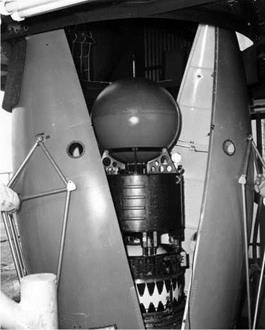R1 – 4 March 1970
 The cause of the failure of R0 was relatively simple, but it was decided to repeat the flight, so that the R1 launch was an exact repeat of R0. This time the vehicle behaved exactly as intended.
The cause of the failure of R0 was relatively simple, but it was decided to repeat the flight, so that the R1 launch was an exact repeat of R0. This time the vehicle behaved exactly as intended.
R2 – 2 September 1970
R2 was launched on 2 September
1970, carrying a spherical
satellite, christened Orba, as its
payload. This was intended to be
a very simple satellite (there was
no money in the budget for
anything more complicated) to
measure the atmospheric drag in
low orbits by observing its orbital Fgure 116 The Orba satellite on top of the
Waxwing motor.
decay. Figure 116 shows the
satellite on top of the Waxwing motor, whilst the payload shrouds are being fitted around it.
The first stage was completely successful, but the second stage shut down 15 seconds early, leaving 30% of the HTP unburned. This turned out to be due to a leak in the HTP tank pressurisation system, with the result that the nitrogen gas ran out early and so there was no pressure in the tank to help feed the propellants. With insufficient pressure the turbopumps cavitate and their effectiveness is much reduced. Hence the second stage thrust dropped to almost nothing. The third stage separated correctly, and fired, but the velocity was insufficient to reach orbit, and the payload crashed into the Gulf of Carpentaria. There were other problems which the subsequent RAE report describes:
Two other defects were recorded during the flight:
The solenoid start switch in the attitude control system failed to latch open on first initiation.
Only one of the two fairings separated correctly from the vehicle at the correct time – separation of the remaining section was delayed until third stage spin up.18
In addition to the drop in pressure in the HTP tank, either of these faults would have prevented the vehicle reaching orbit.
After this flight, an extensive review of the vehicle was set in motion, with eleven technical panels being set up. They began their work in December 1970, and submitted reports and recommendations by the end of June 1971. Relatively few deficiencies were found, and most of these related to the problems that had cropped up in the three development launches. Ian Peattie, who was the Project Officer at RAE for the launch vehicle, commented wryly that the review achieved its objective ‘once certain panel members were persuaded that a fundamental re-design of the launch vehicle was not within the terms of reference.’










